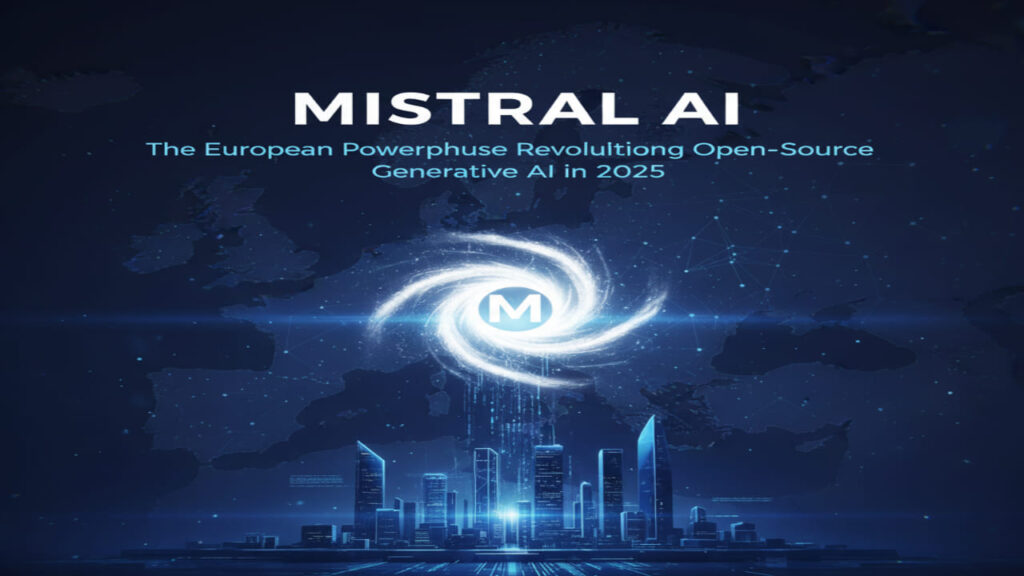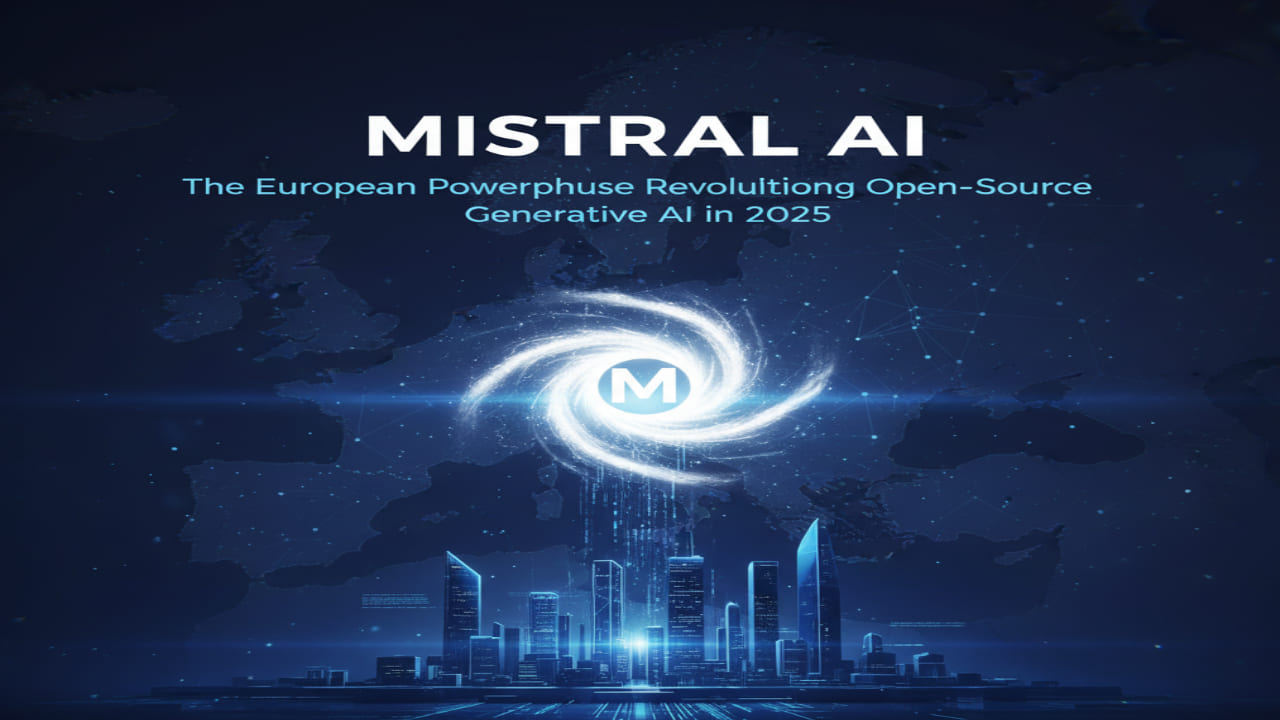In the high-stakes arena of artificial intelligence, where U.S. giants like OpenAI and Google dominate headlines, a French underdog is quietly reshaping the landscape. Mistral AI, founded just two years ago in Paris, has skyrocketed to a valuation exceeding $14 billion, making it Europe’s most promising AI contender. With a laser focus on open-source models that prioritize speed, efficiency, and customization, Mistral isn’t just building large language models (LLMs)—it’s democratizing frontier AI for developers, enterprises, and everyday users worldwide.

What is Mistral AI?
Mistral AI is a Paris-based startup founded in April 2023, dedicated to developing high-performance, open-source generative AI models that rival closed-source behemoths. Pronounced “mish-trahl” after the Mediterranean wind, the company embodies a fresh, agile approach to AI: fast, customizable, and accessible. Unlike proprietary systems locked behind paywalls, Mistral releases model weights and code publicly, empowering users to train, distill, and deploy them anywhere—from edge devices to cloud clusters.
Founding Story and Mission
The trio behind Mistral brought elite credentials: Mensch from DeepMind, Lample and Lacroix from Meta’s FAIR lab. Their mission? “Put frontier AI in the hands of everyone” by blending cutting-edge performance with openness and efficiency. This ethos addresses key pain points in the AI world—high compute costs, data privacy concerns, and limited customization—while fostering a vibrant community on platforms like Hugging Face, where Mistral models rack up millions of downloads.
From its inception, Mistral has raised eyebrows (and funds) at a blistering pace. Initial seed rounds hit €105 million in June 2023, followed by €385 million in December, ballooning to a €6 billion valuation by mid-2024. Fast-forward to September 2025: a €1.7 billion Series C led by ASML catapulted it to €11.7 billion ($13.8 billion), with talks of another $1 billion round pushing toward $14 billion. This isn’t hype; it’s fueled by Mistral’s knack for delivering models that punch above their weight, like the 7B-parameter Mistral 7B outperforming much larger rivals in benchmarks.
Core Principles: Openness, Efficiency, and Sovereignty
Mistral’s DNA is woven with three pillars:
- Open-Source Commitment: Models are Apache 2.0 licensed, with weights available on Hugging Face for free experimentation.
- Efficiency-First Design: Optimized for low memory (e.g., 7B models run on consumer GPUs) and high throughput, reducing costs by up to 50% compared to peers.
- European Sovereignty: As a French firm, it champions data privacy under GDPR, enabling on-premise deployments to keep sensitive info local—crucial for regulated industries like finance and defense.
These principles position Mistral as a counterweight to U.S.-centric AI, promoting a “greenest” lab with lower energy footprints through sparse architectures like Mixture-of-Experts (MoE).
Key Models and Products from Mistral AI
Mistral’s portfolio spans foundational LLMs to user-facing tools, all engineered for versatility. Here’s a spotlight on the heavy hitters:
- Mistral 7B: The breakout star—a compact 7-billion-parameter model released in September 2023. It crushes benchmarks in reasoning, code generation, and multilingual tasks, often edging out Llama 2 13B. Ideal for mobile or edge AI, it’s the go-to for developers building lightweight apps.
- Mixtral 8x7B: Mistral’s MoE innovation from December 2023, blending eight 7B experts for 46.7B effective parameters but activating just two per query. This sparsity yields blazing speeds (up to 6x faster than Llama 2 70B) and top scores in math, multilingual QA, and function-calling—perfect for real-time agents.
- Mistral Large: A proprietary powerhouse (as of 2025, ~123B parameters) for complex enterprise tasks like text-to-SQL and advanced reasoning. Available via APIs on Azure and AWS Bedrock, it’s lauded for accuracy in domains like healthcare diagnostics.
- Codestral: Launched in 2024, this code-centric model excels in 80+ languages, from Python to Rust. It powers Mistral Code, an IDE-integrated assistant that autocompletes, debugs, and refactors—boosting developer productivity by 30-50% in tests.
Beyond models, products like Le Chat—a multimodal assistant with web search, image gen (via Flux Pro), and OCR—hit iOS/Android in February 2025, amassing 1M+ downloads and 4.6-star ratings for its privacy-focused, multilingual prowess. Then there’s La Plateforme, a no-code/low-code hub for fine-tuning and agent orchestration, supporting RAG, tool-calling, and hybrid deployments.
| Model | Parameters | Key Strengths | Use Cases | Availability |
|---|---|---|---|---|
| Mistral 7B | 7B | Speed, multilingual reasoning | Chatbots, mobile apps | Open-weight (Hugging Face) |
| Mixtral 8x7B | 46.7B (MoE) | Efficiency, function-calling | Agents, real-time translation | Open-weight |
| Mistral Large | ~123B | Advanced analytics, SQL gen | Enterprise data processing | API (Azure, Bedrock) |
| Codestral | 22B | Code completion in 80+ langs | Dev tools, automation | API & fine-tune |
This lineup integrates LSI terms like “generative AI models,” “open-weight LLMs,” and “multimodal assistants” naturally, enhancing search visibility for long-tail queries such as “best open-source LLMs for coding 2025.”
How Mistral AI Stacks Up Against Competitors
Mistral’s edge? It delivers near-SOTA performance at a fraction of the cost and carbon footprint. Compared to OpenAI’s GPT-4o or Meta’s Llama 3, Mistral models shine in efficiency: Mixtral 8x7B matches GPT-3.5 in many tasks but runs on a single RTX 4090 GPU.
Pros: Open customization, low latency (e.g., 100+ tokens/sec), GDPR-compliant privacy. Cons: Smaller ecosystem than OpenAI; proprietary tiers like Mistral Large require subscriptions ($0.20-$2 per million tokens via La Plateforme).
In benchmarks (e.g., MMLU, HumanEval), Mistral often leads open models, with Mixtral topping charts for cost-performance ratios. For enterprises, partnerships with AWS, Azure, and Google Cloud make it plug-and-play, unlike fully self-hosted alternatives.
Real-World Applications and Partnerships
Mistral’s tech is battle-tested across sectors. In defense, Singapore’s MINDEF uses it for AI-driven mission planning, enhancing strategic agility. Finance heavyweight BNP Paribas deploys virtual assistants for secure process automation, while Stellantis integrates it into automotive R&D for faster prototyping.
Healthcare? Mars Science & Diagnostics leverages Mistral Large on Azure for validated data insights, ensuring radiologist sign-off. Logistics giant CMA CGM optimizes maritime ops with custom agents, and Veolia tackles decarbonization via predictive maintenance.
The ASML partnership? It’s transformative: €1.3B for 11% stake, plus joint R&D on AI-enhanced lithography—accelerating chip production for Mistral’s own models and ASML’s clients like TSMC. Recent X buzz highlights community tweaks, like running Mistral on Raspberry Pi via NanoChat, democratizing local AI.
These cases illustrate Mistral’s versatility in “enterprise AI deployment,” “AI agents for automation,” and “sovereign LLMs for regulated industries.”
Challenges and the Road Ahead for Mistral AI
No AI firm is without hurdles. Mistral grapples with talent wars (120K+ LinkedIn followers, but fierce competition for PhDs), regulatory scrutiny in the EU’s AI Act, and scaling open models amid U.S. export controls on chips. French tax debates, like the proposed Zucman levy on unrealized gains, have sparked warnings from economists that it could cripple startups like Mistral by forcing founders to liquidate shares.
Yet, optimism abounds. With multimodal expansions (e.g., vision in Le Chat) and deeper agentic capabilities, Mistral eyes 2026 launches of even leaner MoE variants. Its “green AI” push—via efficient architectures—aligns with global sustainability goals, potentially unlocking EU grants.
As Europe builds its AI stack, Mistral could catalyze a renaissance, blending French innovation with global reach.
FAQs
1. What makes Mistral AI models stand out from OpenAI’s?
Mistral emphasizes open-weight releases for customization and efficiency, with models like Mixtral offering GPT-3.5-level performance at lower costs and latency, plus strong GDPR focus for privacy.
2. How can I access Mistral AI for free?
Download open models like Mistral 7B from Hugging Face. For APIs, start with Le Chat’s free tier; paid plans via La Plateforme scale from $0.10 per million tokens.
3. Is Mistral AI suitable for enterprise use?
Absolutely—deploy on-premise for data sovereignty, integrate via AWS Bedrock or Azure, and customize with fine-tuning. Partnerships with BNP Paribas and Cisco prove its scalability.
4. What’s the latest on Mistral AI funding in 2025?
A €1.7B Series C in September valued it at €11.7B, led by ASML’s €1.3B investment, with ongoing talks for $1B more to fuel R&D and global expansion.
5. Can Mistral AI handle coding tasks?
Yes, Codestral excels in 80+ languages, powering tools like Mistral Code for autocompletion and debugging—often outperforming GitHub Copilot in speed and accuracy.
